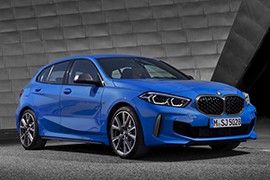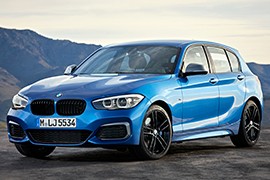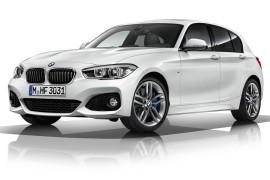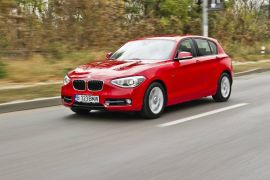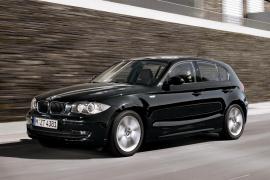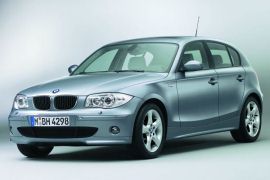BMW 1 Series Models/Series Timeline, Specifications & Photos
First production year: 2004
Engines: Diesel, Gasoline
Body style: Hatchback
The third generation of the BMW 1-Series was a revolution for the small German car since it was based on a front-wheel-drive platform. But it didn't mean it was less performant.
The success story of the 1-Series began in 2004. The sporty, nimble, small car gathered attention from everybody. The second generation was launched in 2011 and it continued the big sales numbers that reached 1.8-million units by the time the third generation appeared.
From first sight, it is impossible not to notice the huge kidney-grille. The angled headlights are going upwards along with the front fenders into a more accentuated slope toward the A-pillars. Since the front-wheel-drive platform was with transverse engines, the whole front of the vehicle was shorter than the one on the previous generation. The shorter front of the car allowed a bigger greenhouse with a long roofline that dropped away toward the rear. A wide tail with big shoulders over the rear wheel arches emphasized the car's sporty look.
Inside the cabin, there was more room than in the previous generation, since the engine and transmission were in front of the windshield. Since there was more room for the front seats, those were installed forward and in effect, the rear legroom was bigger. The driver had a TFT display instead of the usual dials in the instrument cluster. A new infotainment unit that features gesture controls were installed.
Under the hood, there was a wide variety of engines, both diesel, and gasoline with manual or automatic transmission. For specific engine versions, an all-wheel-drive system was available.
BMW did the last upgrade for the second generation of the 1 Series (F20) in 2017, before changing the generation in 2019.
It is usual for a carmaker to improve a vehicle around the middle of that model's lifespan, and BMW named that upgrade as LCI (Life Cycle Impulse). It's like a small bump to increase the sales and dust-off some systems which are no longer trendy among its customers. The 1 Series was the only rear-wheel-drive premium compact hatchback on the market, and the German carmaker bragged about that until it followed the trend and switched to a front-wheel-drive system in 2019.
There were minor changes to the car's exterior. It brought the new Edition Sport Line Shadow, Edition M Sport Shadow, and BMW M140i Edition Shadow special editions. These underlined the car's sporty look introducing a black kidney grille, black inserts in the LED headlights and darkened LED taillights.
Inside, BMW finally introduced the touch-screen infotainment system. While the German carmaker was the first to introduce a combined interface that gathered the audio, phone, and navigation into one unit and named-it iDrive on the BMW 7 Series, it waited a while to offer it with a touch-screen system. The sporty interior look was still the same, with very limited room in the rear due to the high center tunnel needed for the transmission.
BMW kept the three-cylinder engines for the base versions on the engine department, but the customers had a vast choice of engines to chose from. Like its predecessor, the 1-Series featured a rear- or all-wheel-drive system.
BMW 1 Series (F20) LCI 116d 6MT (116 HP)
BMW 1 Series (F20) LCI 116d 8AT (116 HP)
BMW 1 Series (F20) LCI 116d EfficientDynamics 6MT (116 HP)
BMW 1 Series (F20) LCI 118d 6MT (150 HP)
BMW 1 Series (F20) LCI 118d 8AT (150 HP)
BMW 1 Series (F20) LCI 118d xDrive 6MT (150 HP)
BMW 1 Series (F20) LCI 120d 6MT (190 HP)
BMW 1 Series (F20) LCI 120d 8AT (190 HP)
The second generation of the 1 Series from BMW has received an important facelift in 2015. The BMW installed features like automatic climate control, rain sensor, BMW Radio Professional and the iDrive standard on all the range. The 6.5 inches color display is also standard and integrated into the dashboard. It doesn't look like it was installed by the dealers afterward.
The long hood, big wheelbase, and short overhangs add a sporty look to the vehicle. And, in the proper versions and with the proper outside option pack, it is not just a look. It is a warning. The kidney-grille got bigger, and as an option, the reshaped headlights can be equipped with full LED lights. The front bumper inspires an aggressive look.
Under the hood, there is a big range of powertrains, with manual or automatic transmissions. For the first time, the 1 Series can be equipped with the 8-speed Steptronic gearbox from the Japanese manufacturer Aisin.
Five petrol and five diesel engines with BMW TwinPower Turbo technology are available for the 2015 BMW 1-Series. Setting the pace in terms of sports performance is the BMW M135i M with an inline-6 engine now producing 326 hp. The most fuel-efficient is the BMW 116d EfficientDynamics Edition, which combines 116 hp with low fuel consumption of 3.4 liters per 100 kilometers (69.1 mpg-US). Customers can also choose the all-wheel-drive system, BMW xDrive, for the BMW M135i, BMW 120d, and BMW 118d.
BMW 1 Series LCI (F20) 116d 6MT (116 HP)
BMW 1 Series LCI (F20) 116d 8AT (116 HP)
BMW 1 Series LCI (F20) 116d Efficient Dinamics 6MT (116 HP)
BMW 1 Series LCI (F20) 118d 6MT (150 HP)
BMW 1 Series LCI (F20) 118d 8AT (150 HP)
BMW 1 Series LCI (F20) 118d xDrive 6MT (150 HP)
BMW 1 Series LCI (F20) 120d 6MT (190 HP)
BMW 1 Series LCI (F20) 120d 8AT (190 HP)
BMW 1 Series LCI (F20) 116i 6MT (109 HP)
BMW 1 Series LCI (F20) 118i 6MT (136 HP)
BMW 1 Series LCI (F20) 118i 8AT (136 HP)
BMW 1 Series LCI (F20) 120i 6MT (177 HP)
BMW 1 Series LCI (F20) 120i 8AT (177 HP)
BMW 1 Series LCI (F20) 125i 6MT (218 HP)
BMW 1 Series LCI (F20) 125i 8AT (218 HP)
BMW 1 Series LCI (F20) M135i 6MT (326 HP)
BMW 1 Series LCI (F20) M135i 8AT (326 HP)
BMW 1 Series LCI (F20) M135i xDrive 8AT (326 HP)
BMW 1 Series LCI (F20) M140i 6MT (340 HP)
BMW introduced the second generation of the 1 Series in 2011, continuing to threaten other premium car manufacturers that dared to compete in this segment. But unlike any of them, the Bimmer was the only one in its class with a rear-wheel-drive platform, which was a plus and a minus at the same time.
When Audi introduced the A3 on the market in the '90s, it was almost alone in the segment. Mercedes-Benz had the A-Class, but that was a small-sized MPV, not a hatchback. Then BMW joined the bandwagon with the first generation of the 1 Series in 2004 and changed the rules of the game by introducing the RWD-based small-sized premium vehicle. And, when that wasn't enough, it brought the all-wheel-drive versions into discussion when it launched the second generation of the 1 Series, also known as the F20.
Placing such a big front fascia on a small vehicle was considered not exactly elegant, but BMW knew its customers, and it knew that they wanted to have the kidney-grille large enough to be seen by other drivers in their rearview mirrors. Moreover, the headlights' design followed the same design language as the rest of BMW's range, with narrow inner sides and the famous “angel-eye” daytime running lights inside the headlamps. On the bumper, depending on the version, the German automaker installed a set of air intakes on the sides where the fog lamps were fitted. From its sides, the cab-rearward design was obvious thanks mostly to the long and low hood, made to accommodate inline-six engines underneath it. The sculptured door panels featured an ascending line that started from the front wheels and emerged onto the C-pillars. Finally, at the back, the automaker created a tilted forward tailgate adorned with a small roof spoiler on top. Depending on the engine version, underneath the rear bumper, BMW installed a twin or a single exhaust pipe.
Inside, the best seats in the house were at the front. Even the base models featured bolstered seats, and the automaker offered the F20 with a set of high-bolstered ones in the M-Package, which featured adjustable lengths and high-bolstered areas. In front of the driver, the dashboard design was simple and clear, with two dials for the tachometer and speedometer and two smaller ones for the fuel level and engine temperature. On the center stack, again, depending on the options, BMW placed the screen for the infotainment unit that could've been controlled via the rotary knob housed by the center console. In the back, there was hardly enough legroom for three rear passengers, especially since the transmission tunnel crossed the car from front to back.
Under the hood, BMW installed a wide engine range, either gasoline or turbodiesel. These were paired with six-speed manuals or, as an option, with an eight-speed automatic. Depending on the engine version, the car promised excellent fuel efficiency and plenty of fun behind the wheel.
BMW 1 Series (F20) 114d 6MT RWD (95 HP)
BMW 1 Series (F20) 116d 6MT EfficientDynamics RWD (114 HP)
BMW 1 Series (F20) 116d 6MT RWD (114 HP)
BMW 1 Series (F20) 116d AT RWD (116 HP)
BMW 1 Series (F20) 118d 6MT RWD (143 HP)
BMW 1 Series (F20) 118d 8AT RWD (143 HP)
BMW 1 Series (F20) 118d xDrive 6MT AWD (143 HP)
BMW 1 Series (F20) 120d 6MT RWD (185)
BMW 1 Series (F20) 120d 8AT RWD (184 HP)
BMW 1 Series (F20) 120d xDrive 6MT AWD (184 HP)
BMW 1 Series (F20) 114i 6MT RWD (102 HP)
BMW 1 Series (F20) 116i 6MT RWD (136 HP)
BMW 1 Series (F20) 116i 8AT RWD (136 HP)
BMW 1 Series (F20) 118i 6MT RWD (170 HP)
BMW 1 Series (F20) 118i 8AT RWD (170 HP)
BMW 1 Series (F20) 125i 6MT RWD (218 HP)
BMW 1 Series (F20) 125i 8AT RWD (218 HP)
BMW 1 Series (F20) M135i 6MT RWD (320 HP)
In 2004, BMW introduced a model that changed the entire brand: the 1-Series. It was considered the true successor for the legendary BMW 3-Series E30 from the '80s. In 2007 it was enhanced.
The facelift introduced a new bodywork version, a new interior, and new engines. It was a major revamp for the range. Along with the new, three-door version, the entire range was refreshed and updated.
From the outside, the 1-Series with three doors featured a slightly different profile. The longer front doors and the tilting front seats made room for the rear passengers to enter or exit the car. The rear side windows were smaller than on the five-door version. On the front, all the range was fitted with a new grille and a new bumper. The larger kidney-grille was redesigned to improve the air-flow, and, in the back, a restyled pair of taillights completed the image.
Inside, the dashboard changed and the new infotainment system allowed iPod or USB connectivity, but not Android Auto. There was also a button to disable the new automatic start-stop system, which was automatically engaged every time the car was started. For the rear passengers, there wasn't enough legroom or headroom, especially due to the transmission tunnel. The trunk-space was smaller than all the compact-class hatchbacks on the market.
For the engine compartment, BMW 1 Series offered a choice of eight diesel and gasoline units. Apart from the base diesel unit, which was paired exclusively with a 6-speed manual, all of the others were mated with either a 6-speed manual or a 6-speed automatic.
After two unsuccessful generations of the 3 Series Compact, BMW decided to create a completely new lineup named 1 Series.
While the compact segment was very active in Europe, most premium automakers didn't really care about it. Audi was the only contender in the segment with the A3. At the same time, Mercedes tried to convince customers with the compact-sized minivan A-Class and the C-Class Sport Coupe and failed. So, BMW changed the pace and introduced the 1 Series lineup in 2004. It was the only compact-segment, rear-wheel driven hatchback on the market that offered five doors.
Interestingly, the 1 Series didn't look like a shrunk 3 Series with a tailgate. Instead, it featured a distinct front fascia with sharp-looking headlights with swept-back corners on their outer sides. On the sides, the sculptured door panels featured an arched lower line that connected the front and rear fenders. In the four-door version (five with the tailgate), the 1 Series featured split rear windows with a vertical slat, so it could've opened completely. Finally, at the back, the automaker created a slightly tilted forward tailgate flanked by taillights.
Inside, the materials' quality was similar to the one found in a regular 3 Series. For vehicles fitted with a sat-nav system, the screen was above the center stack. The buttons' layout and the instrument cluster resembled the same parts used on other BMWs. As usual, the German automaker installed bolstered front seats for the front occupants for better comfort and a split-folding bench in the back where two people could sit. Yet, the legroom was tiny, and moreover, the transmission tunnel was tall.
Under the hood, BMW installed a broad engine range with four or six cylinders. There were also a few highly fuel-efficient diesel versions.
